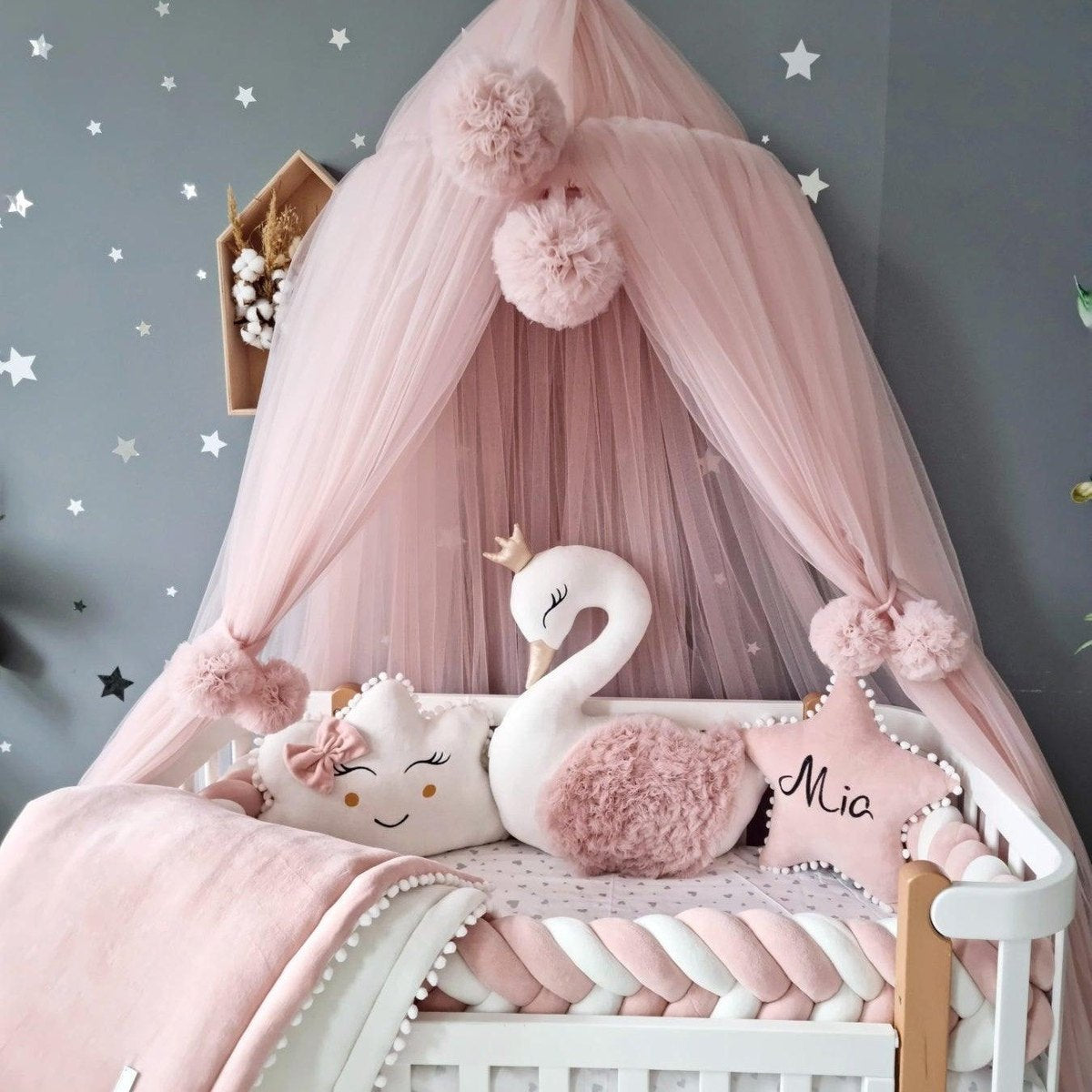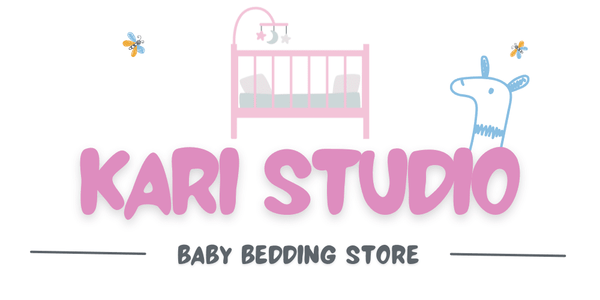Sicherer Schlaf klingt vielleicht einfach. Doch laut CDC sterben in den USA jedes Jahr über 3.500 Säuglinge unerwartet im Schlaf . Man könnte vermuten, dass das Problem auf seltene Bettunfälle oder zufällige Zufälle zurückzuführen ist. Kurioserweise könnten die meisten dieser Tragödien verhindert werden, wenn man ein paar klare Sicherheitsregeln für Kinderbetten beachtet, die viele Menschen übersehen.
Inhaltsverzeichnis
- Die Bedeutung einer sicheren Schlafumgebung
- Wann ist der richtige Zeitpunkt, um in ein Kinderbett umzusteigen?
- Die Entwicklungsmeilensteine Ihres Babys verstehen
- Faktoren, die den Übergang zum Kinderbett beeinflussen
- Vorteile der Umstellung auf ein Kinderbett
Kurze Zusammenfassung
| Wegbringen | Erläuterung |
|---|---|
| Schaffen Sie eine stabile und sichere Umgebung im Kinderbett | Verwenden Sie eine feste Matratze und entfernen Sie weiche Bettwäsche, um das SIDS-Risiko zu verringern. |
| Übergang zwischen 3 und 6 Monaten | Bewerten Sie die Entwicklungsbereitschaft Ihres Babys und überlegen Sie, wann es aus der Wiege herauswachsen kann. |
| Überwachen Sie regelmäßig die Schlafsicherheit | Überprüfen Sie den Zustand des Kinderbetts, einschließlich der Beschläge und der Passform der Matratze, um einen sicheren Schlafplatz zu gewährleisten. |
| Unterstützen Sie die emotionale Bereitschaft zum Schlafen im Kinderbett | Führen Sie das Kinderbett schrittweise ein, da manche Säuglinge Zeit brauchen, um sich an das selbstständige Schlafen zu gewöhnen. |
| Entwicklungsmeilensteine verstehen | Verfolgen Sie wichtige körperliche und kognitive Meilensteine, die auf die Bereitschaft für einen erfolgreichen Übergang ins Kinderbett hinweisen. |
Die Bedeutung einer sicheren Schlafumgebung
Eine sichere Schlafumgebung ist entscheidend für die Gesundheit Ihres Babys und die Reduzierung potenzieller Risiken während der Nachtruhe. Beim Umstieg auf ein Kinderbett müssen Eltern die entscheidenden Elemente eines sicheren Schlafplatzes verstehen.
Grundlagen der Schlafsicherheit bei Säuglingen verstehen
Untersuchungen der National Institutes of Health betonen, dass eine sichere Schlafumgebung nicht nur eine Empfehlung, sondern eine wichtige Schutzmaßnahme für Säuglinge ist. Sichere Schlafbedingungen verringern das Risiko des plötzlichen Kindstods (SIDS) und anderer schlafbedingter Unfälle erheblich.
Wichtige Sicherheitsaspekte für die Schlafumgebung von Säuglingen:
- Verwenden Sie eine feste, flache Oberfläche, die speziell für den Schlaf von Säuglingen entwickelt wurde
- Entfernen Sie alle weichen Bettwaren, Kissen und losen Gegenstände aus dem Schlafbereich
- Sorgen Sie für eine konstante Raumtemperatur zwischen 20 und 22 Grad Celsius.
- Positionieren Sie das Baby bei jeder Schlafphase auf dem Rücken
Gestaltung eines sicheren Kinderbettplatzes
Bei der Vorbereitung eines Kinderbetts sollten Eltern auf Minimalismus und Sicherheit achten. Die Liegefläche muss fest sein und eine eng anliegende Matratze ohne Lücken an den Rändern aufweisen. Vermeiden Sie dekorative Elemente oder zusätzliche Polster , die die Atmung behindern oder zu Überhitzung führen können.
Das Kinderbett Ihres Babys sollte eine sorgfältig gestaltete Umgebung sein, in der Sicherheit vor ästhetischen Aspekten steht. Erfahren Sie mehr über unseren Leitfaden zur Sicherheit von Kinderbettmatratzen, um eine möglichst sichere Schlafumgebung zu schaffen.
Eltern müssen wachsam bleiben und die Schlafbedingungen ihres Babys ständig überwachen. Regelmäßige Kontrollen der Umgebung des Kinderbetts, des Zustands der Matratze und möglicher Gefahren tragen dazu bei, einen sicheren Schlafplatz zu gewährleisten, während Ihr Baby wächst und mobiler wird.
Wichtige Schritte zur Sicherheitsüberprüfung:
- Überprüfen Sie die Beschläge des Kinderbetts monatlich auf lose Schrauben oder mögliche Schäden.
- Überprüfen Sie alle drei Monate Passform und Zustand der Matratze
- Entfernen Sie alle Spielzeuge oder Gegenstände, die eine Erstickungsgefahr darstellen könnten
Durch das Verständnis und die Umsetzung umfassender Schlafsicherheitsprotokolle können Eltern Risiken erheblich reduzieren und ihren Säuglingen eine sichere, komfortable Schlafumgebung bieten.
Wann ist der richtige Zeitpunkt, um in ein Kinderbett zu wechseln?
Um den optimalen Zeitpunkt für den Wechsel Ihres Babys in ein Kinderbett zu bestimmen, müssen Sie Entwicklungsschritte, Schlafmuster und Sicherheitsaspekte berücksichtigen. Eltern fragen sich oft, wann genau der Wechsel von einer Wiege oder einem Beistellbett notwendig wird.
Entwicklungsindikatoren für den Übergang ins Kinderbett
Kinderschlafexperten der American Academy of Pediatrics empfehlen, bei der Umstellung auf ein Kinderbett mehrere Schlüsselfaktoren zu berücksichtigen. Die wichtigsten Indikatoren beziehen sich auf die körperliche Entwicklung und Mobilität Ihres Babys.
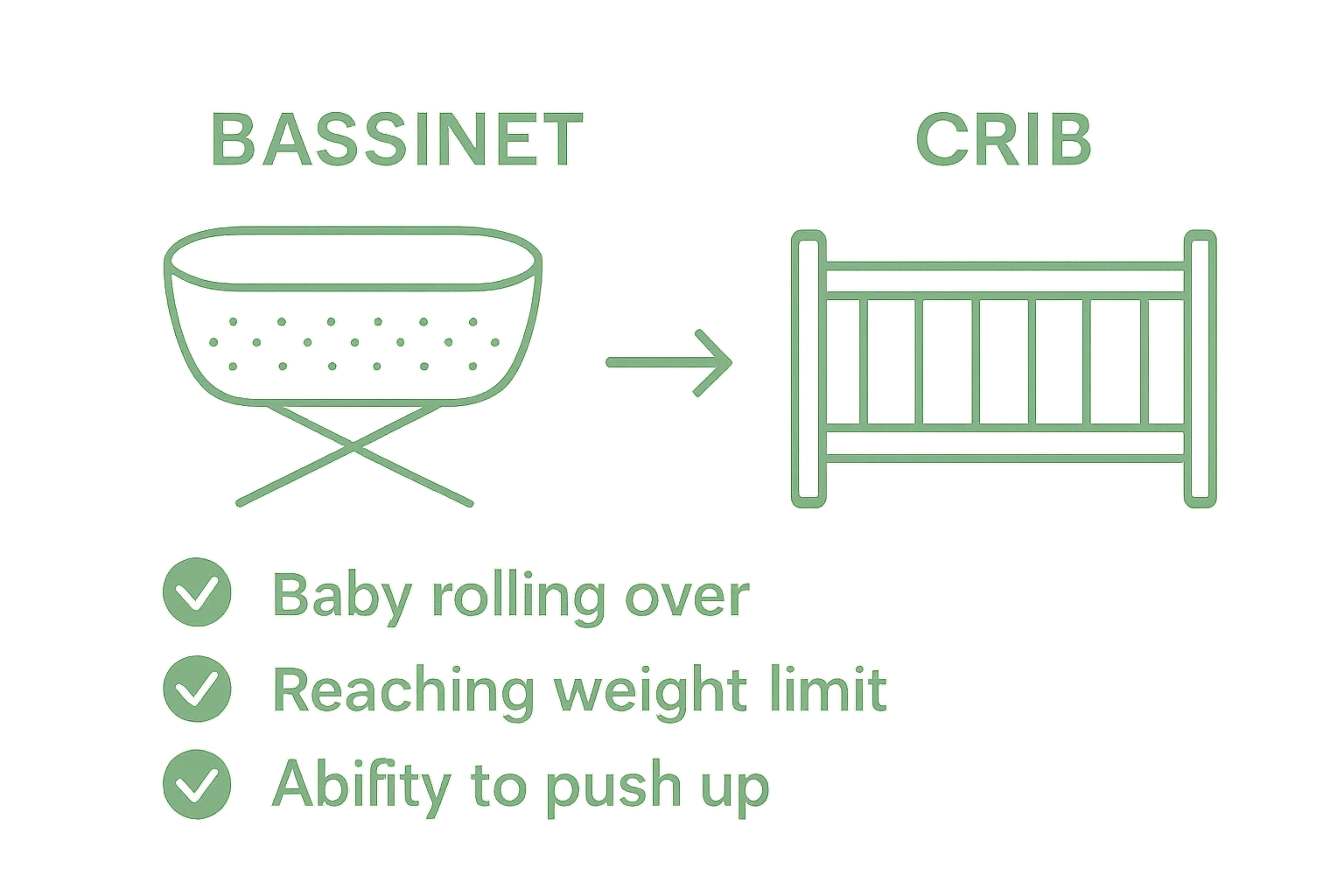
Anzeichen körperlicher Bereitschaft:
- Baby kann sich selbstständig umdrehen
- Zeigt eine erhöhte Kraft im Oberkörper
- Zeigt Anzeichen dafür, dass er versucht, sich hochzudrücken oder hinzusetzen
- Nähert sich der Gewichtsgrenze des aktuellen Schlafplatzes oder überschreitet diese
Zeitliche und Sicherheitsaspekte
Die meisten pädiatrischen Empfehlungen empfehlen einen Übergang im Alter zwischen 3 und 6 Monaten, die einzelnen Entwicklungsstadien variieren jedoch.
Gewicht und Bewegungsfähigkeit spielen eine wichtige Rolle bei der Bestimmung der Bereitschaft. Erfahren Sie mehr über die Wahl des richtigen Kinderbetts für Ihr wachsendes Baby, um einen reibungslosen und sicheren Übergang zu gewährleisten.
Eltern sollten das Schlafverhalten und Wohlbefinden ihres Babys beobachten. Manche Säuglinge gewöhnen sich schnell an neue Schlafumgebungen, andere benötigen eine schrittweise Einführung. Eine feste Schlafenszeitroutine kann den Übergang erleichtern und ein Gefühl der Sicherheit vermitteln.
Checkliste zur Vorbereitung des Übergangs:
- Stellen Sie sicher, dass das Kinderbett den aktuellen Sicherheitsstandards entspricht
- Stellen Sie sicher, dass die Matratze fest sitzt und keine Lücken aufweist
- Behalten Sie vertraute Elemente der Schlafumgebung bei
- Üben Sie kurze Nickerchen tagsüber im Kinderbett, bevor Sie Ihr Baby vollständig in die Nacht versetzen.
Indem Sie den Entwicklungsstand Ihres Babys sorgfältig einschätzen und die Anleitung eines Experten befolgen, können Sie eine fundierte Entscheidung darüber treffen, wann Sie auf ein Kinderbett umsteigen sollten, wobei Sie sowohl Komfort als auch Sicherheit in den Vordergrund stellen.
Die Entwicklungsmeilensteine Ihres Babys verstehen
Entwicklungsmeilensteine stellen wichtige körperliche, kognitive und verhaltensbezogene Merkmale dar, die das Wachstum und die Entwicklung eines Säuglings anzeigen. Diese Meilensteine dienen Eltern als wichtige Wegweiser und helfen ihnen, die sich entwickelnden Fähigkeiten und die mögliche Schlafbereitschaft ihres Babys zu verstehen.
Körperliche Entwicklung und Bewegung
Untersuchungen der Centers for Disease Control and Prevention unterstreichen die Bedeutung der Beobachtung der kindlichen Entwicklung. Körperliche Meilensteine wirken sich direkt auf die Fähigkeit eines Babys aus, sich an ein Kinderbett zu gewöhnen und selbstständig zu schlafen.
Wichtige physische Meilensteinindikatoren:
- Entwicklung der Kopf- und Nackenkontrolle
- Fähigkeit, sich selbstständig umzudrehen
- Kraftsteigerung im Oberkörper
- Entwicklung motorischer Fähigkeiten und Koordination
Kognitive und Schlafbereitschaft
Die kognitive Entwicklung spielt eine entscheidende Rolle bei der Vorbereitung eines Säuglings auf das selbstständige Schlafen. Babys entwickeln Selbstberuhigungsmechanismen und Schlafregulationsfähigkeiten, die zu einem erfolgreichen Übergang ins Kinderbett beitragen. Erfahren Sie mehr über die Entwicklungsstadien von Neugeborenen, um die Entwicklung Ihres Säuglings umfassend zu unterstützen.
Überlegungen zu kognitiven Meilensteinen:
- Erhöhtes Bewusstsein für die Umgebung
- Entwicklung vorhersehbarer Schlafmuster
- Verbesserte Fähigkeit zur Selbstberuhigung
- Reduzierter Schreckreflex
Eltern sollten bedenken, dass Entwicklungsmeilensteine allgemeine Richtlinien und keine strengen Regeln sind. Jedes Kind entwickelt sich individuell, und individuelle Abweichungen sind normal. Die Beobachtung der individuellen Entwicklung Ihres Babys und die Konsultation von Kinderärzten liefern die besten Erkenntnisse über seine Bereitschaft zum Schlafwechsel.
Hier ist eine Tabelle mit einer Zusammenfassung der wichtigsten körperlichen und kognitiven Meilensteine, die darauf hinweisen, dass Ihr Baby bereit für den Übergang ins Kinderbett ist, und die den Eltern die Einschätzung erleichtert.
| Meilensteintyp | Indikatoren |
|---|---|
| Physikalisch | Kopf-/Nackenkontrolle, selbstständiges Rollen, Oberkörperkraft |
| Kognitiv | Vorhersehbare Schlafmuster, Selbstbehagen, Bewusstsein, reduzierter Schreckreflex |
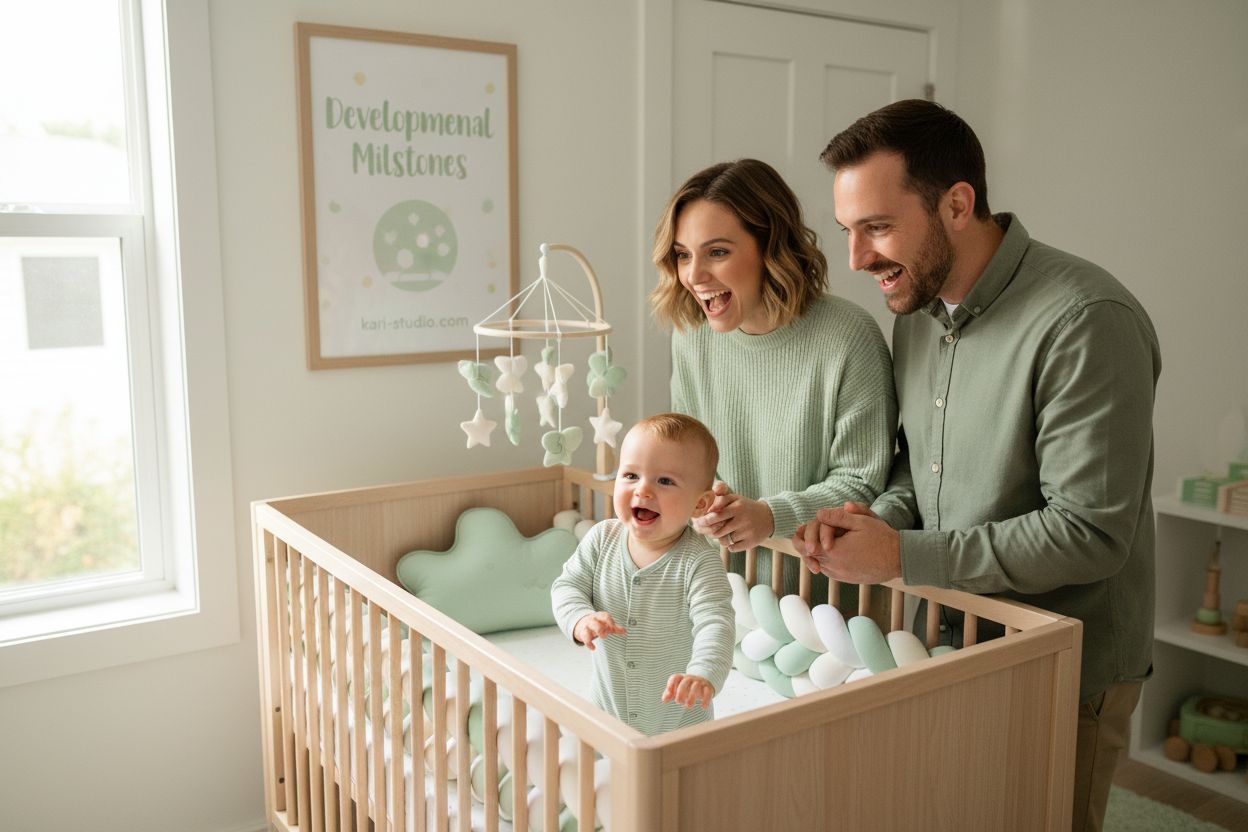
Faktoren, die den Übergang zum Kinderbett beeinflussen
Mehrere miteinander verbundene Faktoren bestimmen, wann und wie erfolgreich Eltern ihr Baby von der Wiege in ein Kinderbett umstellen können. Das Verständnis dieser differenzierten Überlegungen trägt dazu bei, eine ruhige und entwicklungsgerechte Schlafumgebung zu schaffen.
Physische und räumliche Überlegungen
Kinderschlafforscher der Stanford University betonen, dass körperliche Einschränkungen und räumliche Dynamiken eine wichtige Rolle bei der Umstellung auf ein Kinderbett spielen. Raumaufteilung, Möbelplatzierung und die Nähe zu den Eltern sind entscheidende Elemente, die diesen wichtigen Entwicklungsschritt beeinflussen.
Wichtige physikalische Übergangsfaktoren:
- Verfügbarer Schlafzimmerplatz
- Abstand zwischen Elternbett und Babyschlafplatz
- Gewichts- und Mobilitätseinschränkungen der aktuellen Schlafgelegenheit
- Strukturelle Stabilität bestehender Schlafmöbel
Psychologische und emotionale Bereitschaft
Emotionale Vorbereitung geht über körperliche Entwicklungsmerkmale hinaus. Eltern müssen das Wohlbefinden, die Bindungsbedürfnisse und das individuelle Temperament ihres Kindes berücksichtigen. Entdecken Sie die Vorteile von umbaubaren Kinderbetten, die sich an die Bedürfnisse Ihres heranwachsenden Kindes anpassen und einen reibungslosen Übergang ermöglichen.
Überlegungen zum emotionalen Übergang:
- Babykomfort durch selbstständiges Schlafen
- Empfindlichkeit gegenüber Umweltveränderungen
- Vorhandene Schlafassoziationen und -routinen
- Elterliche Angst und Bindungsdynamik
Eine erfolgreiche Umstellung auf das Kinderbett erfordert einen ganzheitlichen Ansatz, der körperliche Bereitschaft, emotionale Sicherheit und praktische Aspekte berücksichtigt. Durch die sorgfältige Berücksichtigung dieser vielschichtigen Faktoren können Eltern eine unterstützende Schlafumgebung schaffen, die eine gesunde Entwicklung und das Wohlbefinden des Kindes fördert.
Nachfolgend finden Sie eine Tabelle mit einem Vergleich der physischen und emotionalen Faktoren, die den Übergang eines Babys von einer Wiege zu einem Kinderbett beeinflussen, wie im Artikel beschrieben.
| Faktortyp | Wichtige Überlegungen |
|---|---|
| Physikalische und räumliche Faktoren | Platz im Schlafzimmer, Abstand zu den Eltern, Gewichts-/Mobilitätsgrenzen, Stabilität der Möbel |
| Psychologische und emotionale Bereitschaft | Komfort beim selbstständigen Schlafen, Sensibilität gegenüber Veränderungen, Schlafroutinen, elterliche Angst |
| Struktur- und Sicherheitsfaktoren | Kinderbett erfüllt Sicherheitsstandards, Matratzenpassform, Gefahrenbeseitigung |
| Entwicklungsmeilensteine | Fähigkeit, sich umzudrehen, Kraft im Oberkörper, Fähigkeit zur Selbstberuhigung |
Vorteile der Umstellung auf ein Kinderbett
Der Übergang zum Kinderbett stellt einen wichtigen Meilenstein in der Entwicklung des Säuglings dar und bietet zahlreiche Vorteile für Baby und Eltern. Das Verständnis dieser Vorteile hilft Familien, fundierte Entscheidungen über die Schlafumgebung und die Säuglingspflege zu treffen.
Körperliche Entwicklung und Sicherheit
Untersuchungen der National Institutes of Health zeigen, dass eine richtige Umstellung auf ein Kinderbett wichtige Aspekte der körperlichen Entwicklung und Sicherheit von Säuglingen unterstützt. Kinderbetten bieten eine strukturierte, sichere Schlafumgebung, die ein gesundes Wachstum fördert und potenzielle Risiken im Zusammenhang mit dem Schlaf von Säuglingen reduziert.
Wichtige körperliche Vorteile:
- Verbesserte Entwicklung der motorischen Fähigkeiten
- Verbesserte Schlafhaltung und Ausrichtung
- Reduziertes Risiko einer versehentlichen Erstickung
- Mehr Bewegungs- und Erkundungsmöglichkeiten
Psychologische und entwicklungsbezogene Vorteile
Der Wechsel ins Kinderbett trägt maßgeblich zur kognitiven und emotionalen Entwicklung eines Säuglings bei. Erfahren Sie mehr über optimale Sicherheitsstandards für Kinderbetten, um diese Entwicklungsvorteile zu maximieren.
Indikatoren für psychologisches Wachstum:
- Erhöhte Unabhängigkeit und Selbstberuhigungsfähigkeiten
- Bessere Etablierung eines Schlafmusters
- Verbessertes räumliches Vorstellungsvermögen
- Verbesserte emotionale Regulierung
Eltern sollten den Wechsel zum Kinderbett als mehr als nur eine logistische Veränderung betrachten. Dieser Prozess stellt eine entscheidende Entwicklungsphase dar, die das wachsende Bedürfnis eines Säuglings nach persönlichem Freiraum, Bewegung und unabhängigem Schlafverhalten unterstützt. Wenn Familien diese Vorteile verstehen und annehmen, können sie dem Übergang mit Zuversicht und positiven Erwartungen entgegensehen.
Sorgen Sie für einen sicheren und bequemen Übergang ins Kinderbett für Ihr Baby
Der Wechsel Ihres Babys in ein Kinderbett ist ein großer Schritt, der sowohl Hoffnung als auch Unsicherheit mit sich bringt. Eltern möchten die Sicherheit und den Komfort ihres Kindes gewährleisten, während es neue Entwicklungsschritte erreicht. Bedenken hinsichtlich der Schlafrisiken und einer sicheren Schlafumgebung sind jedoch berechtigt. Weiche Bettwäsche oder lose Gegenstände können die Schlafsicherheit gefährden. Die richtigen Schutzprodukte können bei dieser Umstellung den entscheidenden Unterschied machen.
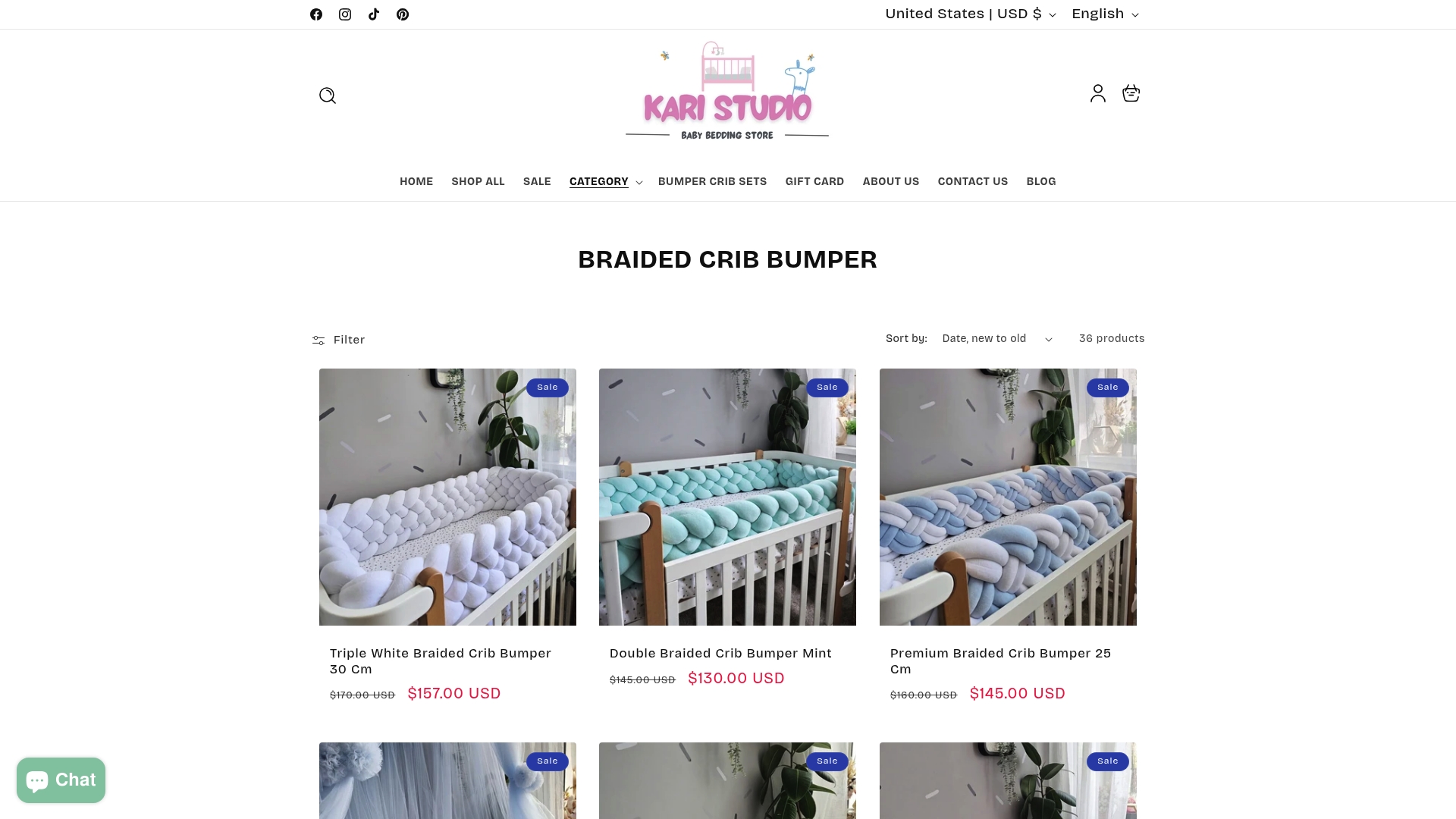
Unterstützen Sie die Unabhängigkeit Ihres Kindes und Ihre innere Ruhe mit unseren geflochtenen Bettumrandungen . Diese Bettumrandungen sind so konzipiert, dass sie sicher um Ihr Kinderbett passen und sowohl Komfort als auch Schutz bieten, damit Sie sich auf die wichtigen Momente konzentrieren können. Besuchen Sie Kari Studio und entscheiden Sie sich für ein Produkt, dem junge Eltern weltweit vertrauen. Geben Sie Ihrem Baby die sanfte, sichere Umgebung, die es verdient. Kaufen Sie jetzt ein und bereiten Sie sich auf jede neue Wachstumsphase vor.
Häufig gestellte Fragen
Wann sollte ich mein Baby von der Wiege in ein Kinderbett umstellen?
Die meisten Empfehlungen von Kinderärzten empfehlen einen Übergang im Alter zwischen 3 und 6 Monaten, abhängig von der körperlichen Entwicklung und Beweglichkeit Ihres Babys, beispielsweise beim Umdrehen und der Gesamtkraft.
Welche Anzeichen deuten darauf hin, dass mein Baby bereit ist, in ein Kinderbett zu wechseln?
Zu den wichtigsten Anzeichen zählen, dass sich Ihr Baby selbstständig umdrehen kann, dass es eine stärkere Kraft im Oberkörper zeigt und dass es sich der Gewichtsgrenze der aktuellen Schlafgelegenheit nähert oder diese überschreitet.
Wie kann ich eine sichere Schlafumgebung im Kinderbett gewährleisten?
Um eine sichere Umgebung im Kinderbett zu schaffen, verwenden Sie eine feste, flache Matratze mit festem Sitz, entfernen Sie weiche Bettwäsche und Spielzeug und legen Sie Ihr Baby zum Schlafen immer auf den Rücken. Sorgen Sie für eine Raumtemperatur von 20–22 Grad Celsius.
Welche Faktoren sollte ich berücksichtigen, bevor ich mein Baby in ein Kinderbett umstelle?
Berücksichtigen Sie die körperliche Bereitschaft Ihres Babys, die Gestaltung des Schlafzimmers, sein emotionales Wohlbefinden und bestehende Schlafassoziationen. Es ist wichtig, eine unterstützende Umgebung zu schaffen, die Unabhängigkeit und Sicherheit fördert.
Empfohlen
- Verstehen, wann Ihr Kind vom Kinderbett umsteigen sollte
- Was ist ein umbaubares Kinderbett? Die Vorteile verstehen – KariStudio
- So wählen Sie das richtige Kinderbett aus: Eine Schritt-für-Schritt-Anleitung für Eltern im Jahr 2025 – KariStudio
- Sicherheit von Kinderbettmatratzen für Ihr Baby verstehen – KariStudio
